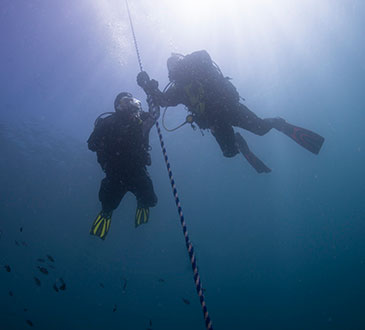Lesson 116
We will talk about Diving with Your Computer
By the end of this section, I should be able to answer these questions:
1. What are six guidelines for diving with a computer?
2. What should I do if my dive computer fails during a dive or between dives?
Computer Diving Guidelines
- Dive the plan. Don’t exceed your planned depth or time just because your computer will let you. But never hesitate to make your dive shorter or shallower if appropriate.
- Stay well within your computer’s limits. Letting your no stop time get to or near 0 is “pushing” the limits – an unwise practice. Always have ample no stop time showing. Head shallower well before your computer nears 0 minutes remaining at your present depth.
- Follow the most conservative computer – yours or a buddy’s. Your and your buddy’s(ies’) computers should have similar readings, but they won’t be identical. Head shallower or end the dive (as needed) based on whomever’s computer nears a limit first.
- Watch your SPG. Check your air supply, not just your no stop time remaining. A good habit is to check both of them together. Air-integrated computers (computers with the SPG built into them) make it easy to check both together. Many of these track your air use and predict your time remaining based on how fast you’ve been breathing and your present depth.
- Start at your deepest point and go shallower. When making more than one dive, plan to make the deepest dive first, with following dives to the same depth or shallower. Generally, avoid large increases in depths after ascending to a shallower depth. Small increases and decreases aren’t an issue. The principle of deep-to-shallow gives you the most no stop time, and is considered more conservative because most test data are based on deep-to-shallow dives.
- Ascend slowly, well within your computer’s ascent rate, and make a safety stop at 5 metres/15 feet for three minutes or longer.
Be a SAFE Diver

Slowly
Ascend
From
Every
Dive
To reduce your risk of decompression sickness or lung overexpansion injuries, remember to be a SAFE Diver. Make a safety stop at 5 metres/15 feet for at least three minutes.
Computer Diving Simulators
One of the best ways to learn about computer diving is to use a computer-based simulator to see how a typical dive computer behaves before, during and between dives.
Computer diving simulators use a graph to show you what to expect from a generic dive computer in different situations. You can also experiment with your own depths and times.
Many computer simulators are designed for training and learning only. Do not use them for planning actual dives unless otherwise specified by the manufacturer.
Dive Computer Failure
Dive computers are highly reliable and failure is very, very rare. Most computers check themselves when you activate them and confirm adequate battery power for 12 to 24 hours (see the manufacturer’s info on this). Failures generally cause a computer to display nothing, or display nonsense. Bad information is very rare. A failed computer may appear to be working later. This is rarely true; computers don’t fix themselves. Have a faulty computer serviced before attempting to use it again, even if it seems fine.
If your computer fails during a dive, you have two options.
Option 1:
Signal your buddy(ies), ascend, make a safety stop and end the dive. If you’re remaining well within limits throughout the dive, you should surface within accepted limits. After surfacing, you must wait 12 or more hours (see the manufacturer recommendations) for your nitrogen levels to return to normal before diving again with a different computer. If you’re writing down your dive depths and times (as you should), you may be able to continue to dive by applying all the information to dive tables. However, multilevel no stop times commonly go over table limits, so this may not work.
Option 2:
Continue the dive using a backup computer. Dive computers are inexpensive enough that more and more commonly, active divers have two. To use this option, you must dive with both computers at all times, and stay within the limits of the most conservative one. A double computer failure is highly unlikely; you can continue the dive and make repetitive dives with your backup. If your backup were to fail

Use Option 1.
If your computer fails during a dive and you’re not wearing a backup, ascend, make a safety stop and end the dive.
If your computer fails between dives during a surface interval and you have not been diving with a backup, you may be able to use tables to continue diving, as described above. Otherwise, wait 12 or more hours (see the manufacturer recommendations) for your nitrogen levels to return to normal before diving again with a different computer.
The Recreational Dive Planner™

As part of your training, your PADI Instructor may have you learn to use the RDP Table or eRDPML. Although most divers use computers today, many still like the option of having tables to assist with dive planning, or as a backup to allow diving when a computer isn’t available or has a problem. The RDP Table and eRDPML include study guides to assist your learning.
knowledge review and quiz
Comments

I'll take you diving!
Copyright © Larry Wedgewood Scuba Instruction All Rights Reserved








